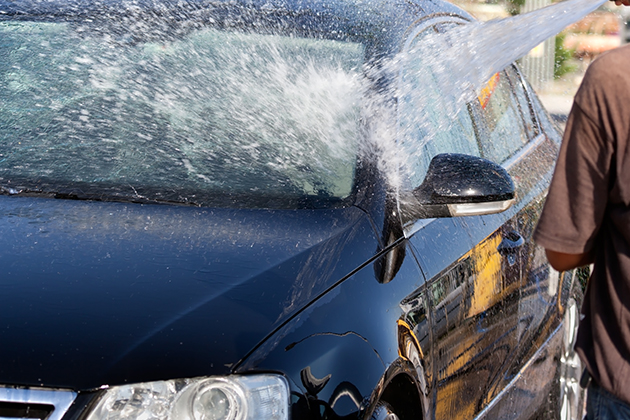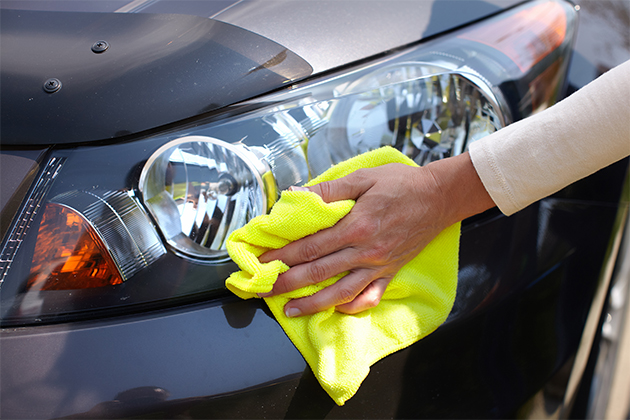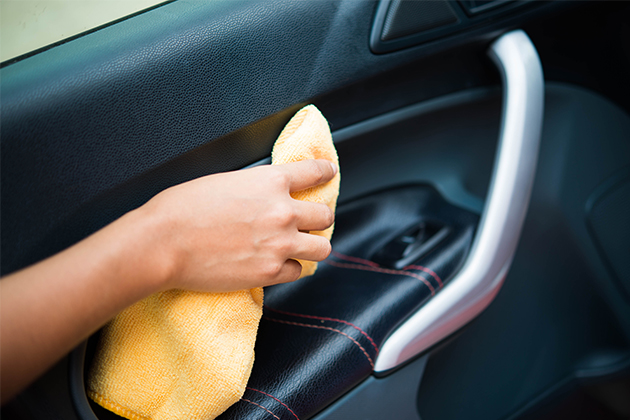Detailing a car isn’t a particularly difficult task but if you choose to have it professionally done, it can become costly.
When done correctly, detailing helps protects your car’s surfaces from long-term damage, preserving its appearance and helping to maximise its resale value.
We’ve spoken to our team of motoring experts to get the lowdown on how to detail your car like a pro.
RELATED:
10 bad car cleaning habits to break »
Exterior
To keep your car’s exterior in good shape, it’s recommended you wash it once a fortnight.
You’ll need:
- A few microfibre cloths (a microfibre cleaning mitt is also worth considering)
- Garden hose (preferably with pressure settings)
- Car shampoo or soap
- Bristled brush
- Tyre-cleaning products such as sprays, scrubs or protectants (optional)
1. Rinse and wash the exterior
When rinsing and washing your car, always work from top to bottom as the bottom is usually the dirtiest. Starting from the top, rinse the exterior using a high-pressure hose. The pressure will ensure any loose dirt or debris will be removed
Once your car has been thoroughly rinsed with the hose, wash it in sections with a microfibre cloth. As an alternative to a microfibre cloth, consider investing in a microfibre cleaning mitt. You wear it on your hand like a glove and it can help you get into hard-to-reach areas. Whichever you choose, start with the roof, then move to the windows, bonnet, middle and lower part of the doors, boot and then the back bumper.
Work on one section at a time and remember to rinse your microfibre cloth well as you go along to remove the dirt you’ve wiped off. This is to avoid rubbing it back into your paintwork which could leave scratches. When the cloth gets too dirty replace it with a fresh one.
Ideally, you should use two buckets when you wash your car – one which contains the car shampoo mixed with water and one filled with just fresh water. You'll use the bucket with the suds to wash the car, then rinse out your microfibre cloth or mitt in the bucket with the fresh water to release any damaging grime that’s caught in the fibres. Give it a quick rinse in the fresh water then plunge it back into the bucket with suds and go again.
Use circular motions to ensure no sections are missed, pulling the cloth towards you so dirt comes away from the surface.

2. Wash the wheels
Once you get to the wheels, don’t use the cloth you’re using on the rest of the car. You should use a bristled brush to wash your wheel rims. This is important as your wheels can have brake pad residue, which could scratch the paint on the rest of the car if you were to use the same microfibre cloth to clean the body of the car with it again.
After rinsing your wheels with the hose to remove surface-level dirt, use the bristled brush with car shampoo to deep clean the wheel’s crevices. Avoid using a metal-bristle brush as this could scratch your tyre rims. If don’t have a bristled brush, a toothbrush will do the job, just a lot more slowly.
If it’s been a while between wheel washes, it may be worth investing in a dedicated wheel-cleaning product. There are a number of wheel-cleaning sprays, scrubs and solutions on the market that can help remove the excess grime that regular car shampoo will struggle to lift.

3. Dry and polish the exterior
Rinse your car one final time to ensure all soap residue is removed. Then, using a different, clean microfibre cloth or microfibre towel, dry the body of your car with slow, circular motions. Be sure to wring out the cloth once you feel it becoming damp. Do this multiple times throughout the drying process. Ensure you open the doors and the boot to dry all areas around the seals.
Once the body of your car is dry, move to the wheels and dry them using a separate microfibre cloth.
Interior
To keep your car’s interior well maintained, it’s recommended you detail it once a month.
You'll need:
- A few microfibre cloths
- Household cleaning spray
- Water, PVA glue and Borax for DIY cleaning slime (optional)
- Household glass cleaner
- Soft brush
- Fabric or leather protectant spray (optional)
- Vacuum with a variety of different-sized attachments and brush types
- Stiff brush
- Vinegar for deodoriser (optional)
4. Clean and polish the dashboard and console
Dashboards can collect a lot of dust and debris, so it’s best to clean your dashboard first. That way any excess dirt that’s wiped off can be easily vacuumed later. As with your car’s exterior, work from top to bottom when cleaning your dashboard to ensure dirt you remove doesn’t contaminate already-clean surfaces.
Begin by wiping your dashboard and console with a clean microfibre cloth. This will lift visible debris from the surfaces. Next, spray a household cleaner (or specialised car interior solution if you have one) onto a clean microfibre cloth and lightly wipe it across the dashboard and console. Then, wipe the areas with clean water on a damp cloth, and dry them with a non-abrasive cloth or paper towels.
If you’re finding it difficult to clean tight nooks and crannies within the console or on the dashboard, try making a DIY cleaning slime. You’ll need the following ingredients:
- Half a cup of room temperature water
- One cup of warm water
- Half a cup of PVA glue
- One teaspoon of Borax
In a bowl, combine the room temperature water and glue and stir well. In a separate bowl, combine the Borax with the warm water and stir until dissolved. Then, slowly add the Borax solution to the glue mix while stirring. This will create a putty-like substance that is effective in catching any loose dirt particles.
5. Clean the windows
To clean your windows, dampen a microfibre cloth with soapy water and use a figure eight motion while applying light pressure to remove dust and dirt. The soapy water won't damage window tinting, like household window cleaners can.
Once the soapy water has been applied, use a separate microfibre cloth to polish the windows and remove any streaks, paying attention to the corners and edges of windows.
6. Clean and maintain car seats
To clean cloth car seats, vacuum them to remove surface-level dirt then spray a light cleaning solution onto the seats. Use a soft brush to massage the solution into the seat then wipe away moisture or suds with a dry microfibre towel.
If you have leather car seats, ensure they are well-conditioned to avoid cracks or fading. To clean them, begin by vacuuming any loose dirt and follow with a leather cleaner, using a soft brush to smooth it over the seats. Use a dry microfibre towel to wipe away excess moisture and leave the seats to dry for a few hours.
7. Clean and maintain door panels
For door handles and window buttons or cranks, use a soft brush sprayed with a household or interior car cleaner. A sponge can also be used, just ensure the door is dried well with a clean microfibre towel afterwards.
If your door panel is fabric, vinyl or leather, use a suitable protectant. As with the handles and window buttons, always ensure you wipe away any cleaning residue and leave the surface dry.

8. Vacuum the floor and floor mats
To effectively vacuum your car, you'll need a powerful vacuum cleaner and an assortment of attachments and brush types. Begin by vacuuming the visible loose dirt. Where possible remove floor mats and clean them separately.
Once larger surfaces are dirt-free, use your attachment brushes to remove dirt trapped in the fibres of your car’s interior. A stiff brush is ideal for this as it can help remove particles stuck in smaller nooks of your car’s carpet. Don’t forget to clean the carpet under the seats.
9. Deodorise the interior
As a finishing touch, a DIY deodoriser is a great way to keep your car smelling fresh and clean, and to mask any strong odours. One option is to combine an equal amount of white vinegar with water in a spray bottle and lightly spray inside the car. White vinegar acts as an odour remover so when it dries, the smell should be gone.
Another option is to sprinkle baking soda on the carpet to remove any moisture or mouldy smells. Let it sit for a few minutes, then vacuum it clean.
Ready to give your car a refresh?
RAC members save up to 20% on a range of car cleaning products from Repco.
Last updated February 2021
